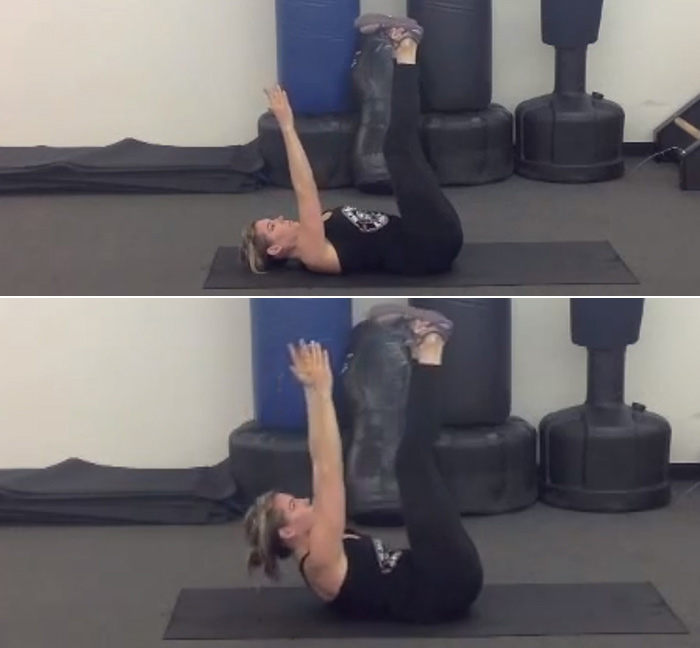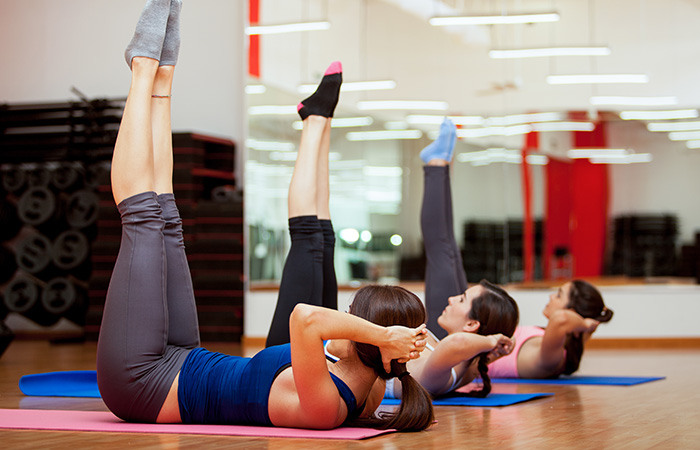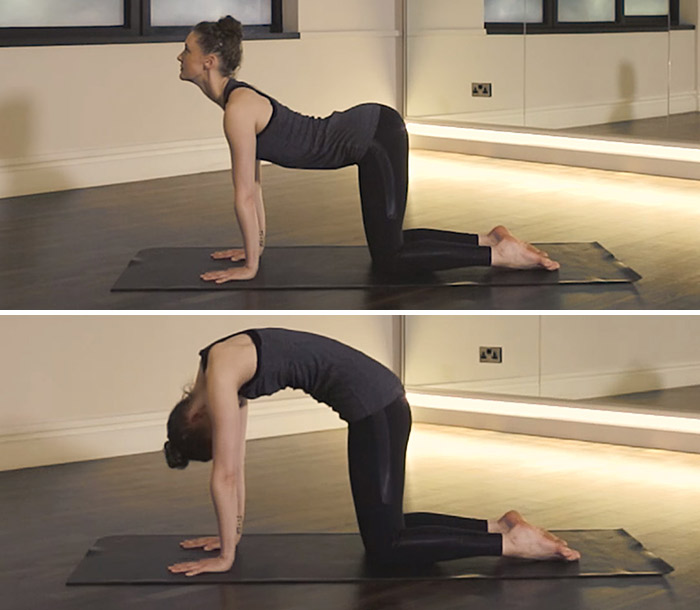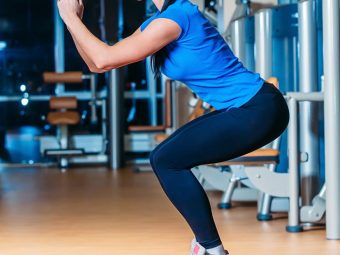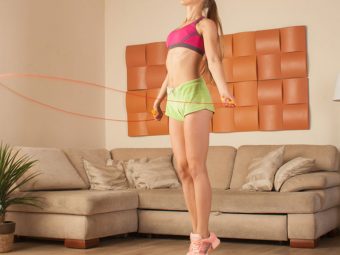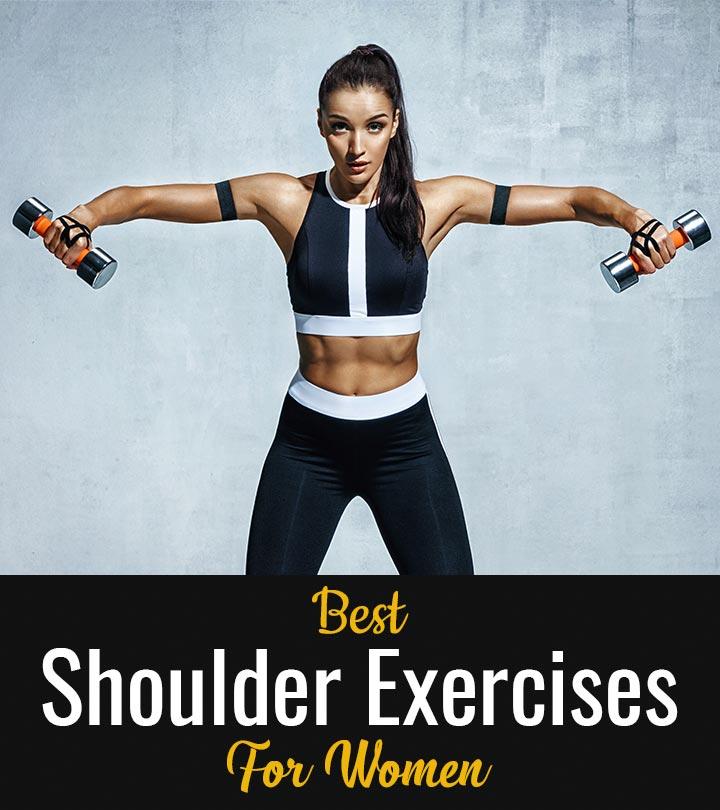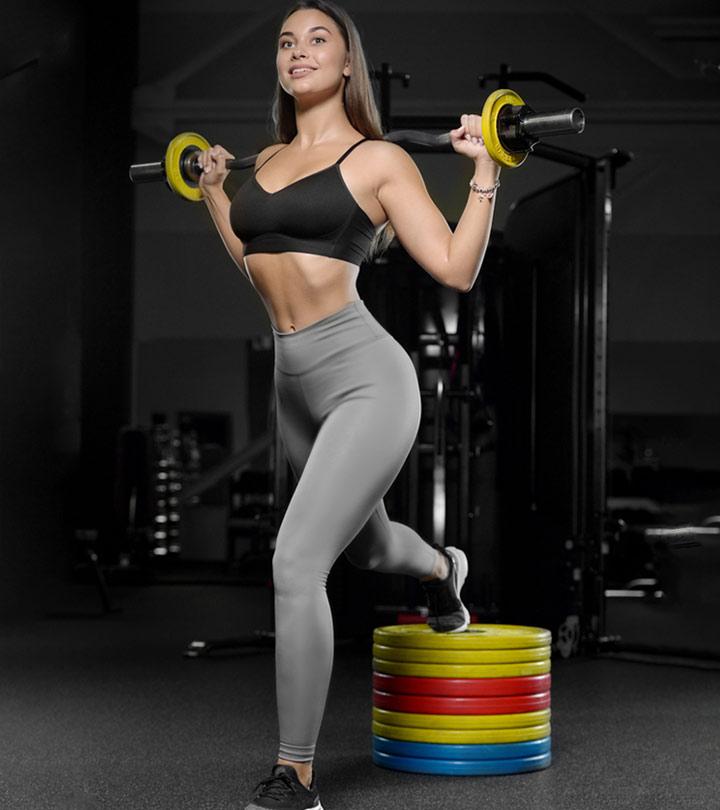16 Best Core Strengthening Exercises You Can Do At Home
Strengthen your abs, back, glutes, and pelvis muscles with easy yet effective exercises.

Image: Shutterstock
Core strengthening exercises are important to keep your spine stable, which helps you stand and sit without falling (1). Core muscles include the abs, back, glutes, and pelvis (2). But with age or due to a sedentary life, the core muscles may weaken and cause injuries that may affect posture (3), (4). To prevent that from happening, you can perform core strengthening exercises or an abs workout every other day for 20 minutes (5), (6), (7), (8), (9).
Read on to get a list of the 16 best core strengthening exercises you can perform at home with proper technique.
You also can check out the core muscles you will target through the core strengthening exercises mentioned below. Continue reading.
 Workout Blueprint: Core Strengthening Exercises
Workout Blueprint: Core Strengthening Exercises- Frequency: 2-3 times per week
- Benefits: Stabilize the spine and improve posture and respiratory function.
- Equipment Needed: Exercise mat
- Space Required: Small area
- Assistance Required: No
- Who Should Avoid: Anyone with chronic joint pain and lower back issues and anyone who has undergone surgery recently.
In This Article
What Is The Core? What Muscles Is The Core Made Of?
The Department of Physical Medicine and Rehabilitation, University of Colorado School of Medicine defines the core as “the group of trunk muscles that surround the spine and abdominal viscera. Abdominal, gluteal, hip girdle, paraspinal, and other muscles work in concert to provide spinal stability.” (10)
This means the core includes your belly region, upper back, lower back, hips, sides of the waist, and chest.
Here’s the list of all the core muscles:
- Rectus Abdominis – These are the muscles that correspond to the popularly known ‘six-pack’, seen as those squarish parts in the middle. They are located along the front of the abdomen.
- External Abdominal Obliques – These are the muscles seen pointing diagonally downwards from either side. They are located on the sides and front of the abdomen.
- Internal Abdominal Obliques – These muscles are under the external abdominal obliques but point in the opposite direction.
- Transverse Abdominis – These are the deepest muscles, behind the oblique muscles and around the spine.
- Glutes – These are the hip muscles that help in various movements like walking, sitting, and bending.
- Pelvic Floor – These are the muscles that you can feel when you try holding your urine. You will know your pelvic floor muscles are weak if you pass a little urine unintentionally when you cough, sneeze, or workout.
- Scapular Muscles – These muscles include the ones present on your upper back and at the back of your shoulders – the trapezius, rhomboid, teres minor and major, pectoralis minor, etc.
Now, you know that to strengthen the core, you must target all the muscles mentioned above. Let’s get started with the exercises.
Top 16 Core Strengthening Exercises You Can Do At Home
Before any exercise session, you must warm-up. Here’s a 10-minute warm-up session you may follow.
Warm-Up (10 minutes)
- Neck tilts – 1 set of 10 reps
- Head up and down – 1 set of 10 reps
- Neck rotations (do it slowly) – 1 set of 10 reps
- Shoulder rotations – 1 set of 10 reps
- Elbow rotations – 1 set of 10 reps
- Arm rotations – 1 set of 10 reps
- Waist rotations – 1 set of 10 reps
- Spot jogging – 1 min
- Side lunges – 1 set of 10 reps
- Calf raises – 1 set of 10 reps
- Ankle rotations – 1 set of 10 reps
Note: If you have lower back pain, start with the basic core exercise first. Do core activation, core with knee in and out, core with hip knee flexion, and then progress to below exercises that can help you get a strong core.
Core Exercises – 20 minutes
1. Flutter Kicks
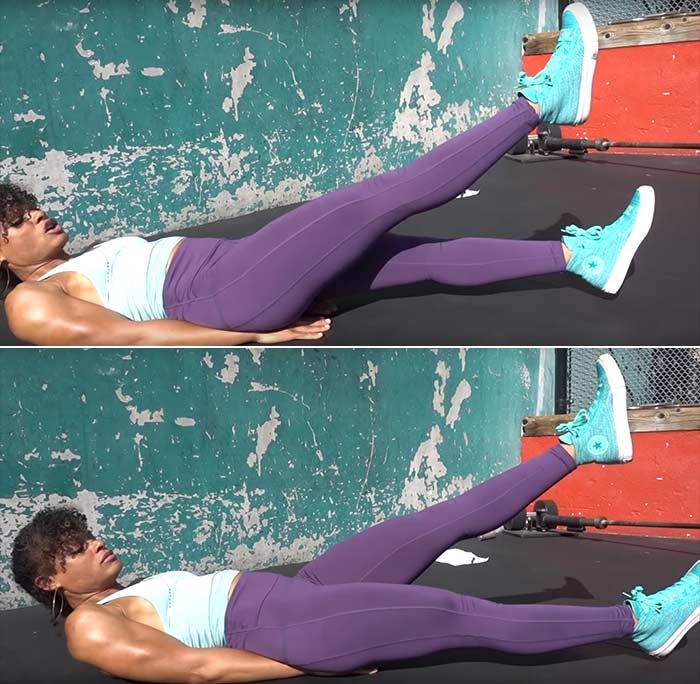
Target – Glutes, hip flexors, lower abs, quads, and hamstrings.
How To Do Flutter Kicks
- Lie down on your back on a mat. Keep your hands by your side, palms flat on the mat, back flat against the mat, and look up at the ceiling.
- Engage your core, lift both your legs off the ground and kick them up and down alternately. Do not let your feet touch the ground before you complete one set.
Sets And Reps – 2 sets of 15 reps
Note: If you practice pilates, you can do a variation of this exercise where you lift both (or alternate) legs and touch the ground with the toes.
 Quick Tip
Quick Tip2. Seated Knee Tuck

Target – Upper, middle, and lower abs, glutes, quads, hamstrings, calves, biceps, and triceps.
How To Do Seated KneeTucks
- Sit on the mat with your knees flexed and feet flat on the mat. Place your hands behind you, and keep your palms flat on the mat.
- Engage your core, bend your elbows, lean back a bit, and lift your legs in the same flexed knee pose.
- Bring your knees close to your chest, and your upper body close to your knees.
- Lean back and push your legs away. Straighten your legs as you do it.
- Flex your knees and bring them close to your chest, and your upper body close to the knees.
Sets And Reps – 3 sets of 10 reps
3. Crunches
Target – Rectus abdominis, transverse abdominis, internal and external obliques, and pelvis.
How To Do Crunches
- Sit on the mat with your knees flexed and feet flat on the mat. Keep your feet together.
- Roll back until the back of your shoulders touches the mat. Do not rest your head on the mat.
- Engage your core and place your fingertips behind the head to support it. Keep your elbows out, arms wide open, and chest out. Do not tuck your chin. This is the starting position.
- Exhale and lift your head (do not push it) so that only the upper back is off the ground. Look at the top of your knees.
- Inhale and slowly go back to the starting position.
Sets And Reps – 2 sets of 15 reps
If you are comfortable with this and looking to raise the difficulty level of your workout routine, you can try reverse crunches.
Jessica Morales, a blogger, shares a personal fitness journey of completing 100 crunches daily for six months. She says, “After six months of consistent effort, I began noticing significant changes in my abdominal muscles (i).”
4. Bicycle Crunch
Target – Upper, mid, and lower abs, obliques, quads, and hamstrings.
How To Do Bicycle Crunches
- Lie on the floor, place your hands behind your head, and open your arms. Raise your head and your feet off the floor, flex your knees, and bring them close to your belly.
- Push the right leg back and extend it. Simultaneously, crunch up and try to touch your left knee with your right elbow.
- Fold your right knee. As you do so, push your left leg back and extend it fully. Crunch up and try to touch your right knee with your left elbow.
- This completes one rep.
Sets And Reps – 2 sets of 15 reps
You can try the pilates double leg stretch exercise to bring in some variation.
6. Vertical Leg Crunch
Target – Upper, mid, and lower abs, obliques, quads, hamstrings, rhomboids, lats, and deltoids.
How To Do Vertical Leg Crunches
- Lie flat on the floor and keep your arms by your side.
- Lift both your legs at 90 degrees from the floor.
- Lift your hands off the floor and try to touch your toes with your fingertips.
- Inhale and go back down.
- Exhale and try to touch your toes with your fingertips.
Sets And Reps – 2 sets of 15 reps
Note: Hollow body hold is a difficult variation of this exercise where you have to lift your shoulder blades, arms, legs, and head off the floor at the same time and hold the position.
7. Leg Raises
Target – Glutes, lower abs, upper abs, hamstrings, and quads.
How To Do Leg Raises
- Lie down on the mat. Place your thumbs under your hips, engage your core, and raise your leg vertically. This is the starting position.
- Inhale and lower your legs slowly.
- Just before your heels touch the floor, raise them slowly. Exhale as you do so.
Sets And Reps – 3 sets of 12 reps
Note: The boat pose is a difficult variation of this exercise. To do this yoga pose, raise the legs at a 45° angle and lift the torso to form a “V” shape.
8. Plank
Target – Abs, glutes, quads, shoulders, hamstrings, and biceps.
How To Do A Plank
- Get on all fours from a kneeling position.
- Flex your elbows and place your forearm on the mat. Extend your legs behind and engage your core. Make sure your neck and spine are in a straight line. Do not bend or pike up.
- Keep your elbows right below your shoulders. Look down at the floor. Avoid any strain on your head and neck. Keep breathing.
- Hold this pose for 30-60 seconds.
Sets And Reps – 2 planks of 30-60 seconds hold
Once you are comfortable and have mastered the basic crunch, you can go for the side plank for better core strength.
9. Plank Jacks
Target – Abs, glutes, adductors, abductors, calves, and hamstrings.
How To Do Plank Jacks
- Assume the push-up position. Keep your core engaged and legs hip-width apart.
- Keeping your upper body and hands steady, move your legs apart (wider than shoulder-width) and then bring them back to the starting position. Here, you will be doing the leg movement of jumping jacks in the plank position.
Sets And Reps – 3 sets of 20 reps
10. Sprinter Plank
Target – Abs, glutes, adductors, abductors, calves, and hamstrings.
How To Do Sprinter Plank
- This exercise is also called the mountain climbers exercise. First, assume a push-up position. Make sure your neck and back are in the same line, elbows right below your shoulders, and core engaged.
- Lift your right foot off the floor, bend your right knee, and bring it close to your belly.
- Place the right foot on the floor, hop, and lift your left foot off the floor.
- Bend your left knee and bring it close to your belly.
- Place your left foot on the floor, hop, and lift your right foot off the floor.
- Do this at a higher speed, almost like running or sprinting.
Sets And Reps – 3 sets of 20 reps
11. Cat And Cow
After doing so many exercises in the plank pose, your back needs to be relaxed. The Cat and Cow Pose that is often practiced in yoga is the perfect exercise for that.
Target – Relaxing the back muscles.
How To Do Cat And Cow Pose
- Get on all fours. Roll your shoulders back, keep your elbows right below your shoulders. Keep your back straight. Do not pike up or bend down your spine.
- Bend your spine and look up. Hold this pose for 3 seconds.
- Slowly, lower your head, look down, and pike up your spine. Hold this pose for 3 seconds.
Sets And Reps – 1 set of 10 reps
12. Jack Knife Crunch
Target – Lower abs, upper abs, glutes, hamstrings, quads, and lower back.
How To Do Jack Knife Crunch
- Lie down on a mat. Extend your hands overhead. Feel the stretch. This is the starting position.
- Lift your legs and hands off the floor, crunch, and touch your knees with your hands.
- Slowly, lie down again and get back to the starting position.
Sets And Reps – 3 sets of 8 reps
After doing the jack-knife crunch, you can try a difficult variation of this exercise known as V-ups to further improve your core strength.
13. Push-up
Target – Abs, chest, shoulders, and biceps.
How To Do A Push-Up
- Get down on the floor and push your legs backward until they are fully extended and resting on your toes.
- Keep your hands firmly planted on the floor on either side of you, slightly wider than shoulder-width apart. Your arms and legs should be straight. Your body should be in a straight line from head to heels.
- Inhale, pulling in your navel, and bend your elbows out to 90 degrees (and no more) while lowering yourself to the floor. Keep your body straight throughout. Keep the pressure on the outside of your palms.
- Exhale and raise yourself to the starting position. Do more repetitions at a slow and steady pace, without compromising on the form.
- If this is too hard, you can do modified versions of this exercise. One is by resting your palms on a bench or table instead of the floor. Another is by resting on your knees instead of your toes.
Sets And Reps – 3 sets of 8 reps
Note: The bird dog exercise is a great way to raise the difficulty level of this basic push-up exercise. Raise the alternate hand and leg parallel to the ground and hold it for a few seconds.
14. Russian Twist
Target – Internal and external obliques, rectus abdominis, traps, and spinal erectors.
How To Do The Russian Twist
- Sit on the mat with your knees flexed and feet flat on the mat. Hold the medicine ball or dumbbell with both your hands and lean back a little.
- Engage your core, lift your legs in the same flexed knee pose, and cross them.
- Start twisting from side to side. Keep your lower body and neck still.
Sets And Reps – 3 sets of 15 reps
Note: If you want to try a variation and bring balance to your core try L-sits.
 Trivia
Trivia15. Inchworm

Target – Abs, lower back, deltoids, glutes, and biceps.
How To Do Inchworm
- Stand straight with your feet shoulder-width apart, shoulders rolled back, chin up, and core engaged.
- Bend down and touch the floor close to your feet with your fingertips. Your hips should point to the ceiling. Do not bend your knees.
- Start walking with your hands and move forward.
- Stop when you come to a plank pose.
- Hold this pose for a second and then walk back to the standing position.
Sets And Reps – 1 set of 3 reps
Note: Rollouts is a variation of this exercise as it targets your abs and helps in toning.
16. Oblique Crunch
Target – Abdominal and oblique muscles
How To Do Oblique Crunch
- Lie on your right side as you keep your right hand flat and extended on the exercise mat.
- Bend your left hand and place it behind your head with your elbow facing outward.
- Extend your feet and keep them slightly off the floor.
- Bend your knees and bring them towards your chest, and try touching your left elbow to your left knee. Keep your abs squeezed while performing this step.
- Pause before extending your legs back and going back to the starting position.
- Exhale as you crunch up and twist, and inhale as you return to the starting position.
Sets And Reps – 2 to 3 sets of 8 to 12 reps on each side
These are the 16 core strengthening exercises that you can do at home at your convenience. Make sure you stretch and cool down after finishing your workout session.
Doing these exercises every other day can help you get the following benefits.
Benefits Of Core Strengthening Exercises
- Help you get a flat tummy.
- Improve core muscle power.
- Improve muscle coordination.
- Prevent injury.
- Help stabilize the torso.
- Improve respiratory function.
- Improve posture.
- Stabilize the spine, ribs, and pelvis.
Infographic: 5 Best Exercises To Strengthen Your Core At Home
Strong core muscles improve balance and promote better posture. However, aging and a lack of regular exercise can weaken these muscles and make one more susceptible to injuries. But there is some good news – you can strengthen your core muscles in the comfort of your home without having to spend big bucks on a gym membership. In the infographic below, we have listed 5 easy-to-do core strengthening exercises suitable for all, including beginners. Check them out.

Illustration: StyleCraze Design Team
Core strengthening exercises work on your abs, obliques, glutes, back, and pelvic floor muscles, to give you a strong torso and flexible spine. These exercises not only help make your core muscles stronger but also help lose that stubborn belly fat. Crunches, plank exercises, push-ups, sit-ups, stability ball exercises, and flutter kicks are some of the various exercises that can help you lose fat, tone the abs, and get a strong core. Complementing this with a balanced diet with no junk or processed food is important to see a difference in the fat reduction. Doing these just for 30 minutes every day would help improve posture while strengthening your core and back over time.
Frequently Asked Questions
Is walking good for core strength?
Walking is a good cardio exercise and will help burn calories. However, it is not the ideal workout for strengthening the core.
How can I strengthen my core while sitting?
You cannot strengthen your core by sitting. You have to activate your core muscles by doing exercises that target the core muscles.
Does core strengthening help back pain?
Yes, correct and supervised core exercises can help reduce back pain. For example, the dead bug exercise helps with lower back pain. However, make sure you talk to your doctor and make your trainer aware of your back pain.
What is the appropriate repetition tempo for core-strength exercises?
As a beginner, try 2 sets of 8 reps. Increase it to 3 sets of 8 reps. Later, 3 sets of 12 reps. The sets and reps also depend on the type of exercise you do.
Why are core exercises so hard?
Unlike the other body parts, the muscles around the abdomen are immovable. Hence, any movement of the hands or legs puts pressure on the core – making such exercises more challenging.
What problems can a weak core cause?
Weak core muscles can lead to poor posture and affect the sense of balance. Also, they can lead to lower back pain and weakness in general.
How long does it take to strengthen a weak core?
Research suggests that strengthening a weak core can take about 8 weeks. But once strong, your core can help improve your balance, increase endurance, and improve your running economy (11).
Key Takeaways
- Core strengthening exercises may strengthen the abdominal, pelvic, and back muscles.
- Maintaining core strength may improve posture, stability, and core power.
- Some of the exercises you can try at home for core strengthening include Russian twists, planks, leg raises, and crunches.
- Following a balanced diet and avoiding junk food along with these exercises is necessary for effective results.

Image: Stable Diffusion/StyleCraze Design Team
Are you looking for an exciting fitness adventure designed for kids and teens? Check out the video below to discover a fun and engaging core strength workout that will help kids build a strong foundation to improve their overall fitness.
Personal Experience: Source
StyleCraze's articles are interwoven with authentic personal narratives that provide depth and resonance to our content. Below are the sources of the personal accounts referenced in this article.
i. Why I Did 100 Crunches Every Day for 6 Months (And The Results I Got)https://medium.com/@jess_aboutfitness/why-i-did-100-crunches-every-day-for-6-months-and-the-results-i-got-6a5528874bcd
References
Articles on StyleCraze are backed by verified information from peer-reviewed and academic research papers, reputed organizations, research institutions, and medical associations to ensure accuracy and relevance. Read our editorial policy to learn more.
- Effects of core strength training on core stability. Journal of Physical Therapy Science, US National Library of Medicine, National Institutes of Health.
https://www.ncbi.nlm.nih.gov/pmc/articles/PMC6110226/ - Core stability: The centerpiece of any training program. Current Sports Medicine Reports, SpringerLink.
https://link.springer.com/article/10.1007/s11932-005-0064-y - Disuse-induced muscle wasting. The International Journal of Biochemistry and Cell Biology, US National Library of Medicine, National Institutes of Health.
https://www.ncbi.nlm.nih.gov/pubmed/23800384 - Age-related and disease-related muscle loss: the effect of diabetes, obesity, and other diseases. The Lancer, Diabetes And Endocrinology, US National Library of Medicine, National Institutes of Health.
https://www.ncbi.nlm.nih.gov/pmc/articles/PMC4156923/ - The relationship between core endurance and back dysfunction in collegiate male athletes with and without nonspecific low back pain. International Journal of Sports Physical Therapy, US National Library of Medicine, National Institutes of Health.
https://www.ncbi.nlm.nih.gov/pmc/articles/PMC4886801/ - The effects of core stability strength exercise on muscle activity and trunk impairment scale in stroke patients. Journal of Exercise Rehabilitation, US National Library of Medicine, National Institutes of Health.
https://www.ncbi.nlm.nih.gov/pmc/articles/PMC3836527/ - The Additive Effects of Core Muscle Strengthening and Trunk NMES on Trunk Balance in Stroke Patients. Annals of Rehabilitation Medicine, US National Library of Medicine, National Institutes of Health.
https://www.ncbi.nlm.nih.gov/pmc/articles/PMC4775748/ - Core strength training for patients with chronic low back pain. Journal of Physical Therapy Science, US National Library of Medicine, National Institutes of Health.
https://www.ncbi.nlm.nih.gov/pmc/articles/PMC4395677/ - Acute effects of core stability exercises on balance control. Acta of Bioengineering and Biomechanics, US National Library of Medicine, National Institutes of Health.
https://www.ncbi.nlm.nih.gov/pubmed/30520448 - Core stability exercise principles. Current Sports Medicine Reports, US National Library of Medicine, National Institutes of Health.
https://www.ncbi.nlm.nih.gov/pubmed/18296944 - Effects of 8-week core training on core endurance and running economy, National Library of Medicine, National Center for Biotechnology Information
https://www.ncbi.nlm.nih.gov/pmc/articles/PMC6407754/







